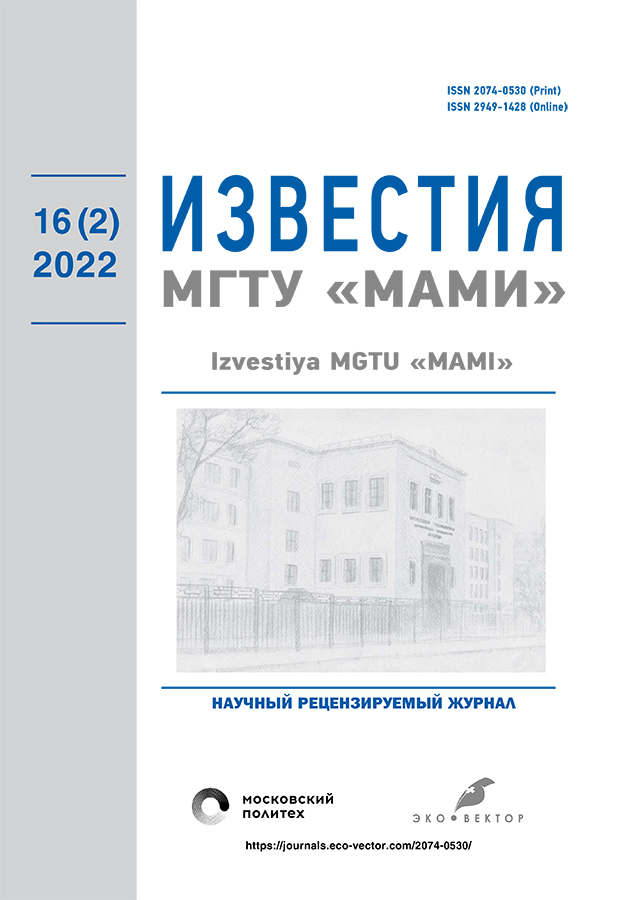On the issue of technical compatibility of electrotechnical complexes and systems of aircrafts
- Authors: Chernov A.E.1, Maleev R.A.2, Eroshkin D.A.1, Lavrikov A.A.2
-
Affiliations:
- Peter the Great Military Academy of Strategic Rocket Forces
- Moscow Polytechnic University
- Issue: Vol 16, No 2 (2022)
- Pages: 183-190
- Section: Electrotechnical facilities and systems
- URL: https://journals.eco-vector.com/2074-0530/article/view/108914
- DOI: https://doi.org/10.17816/2074-0530-108914
- ID: 108914
Cite item
Abstract
BACKGROUND: Among the variety of different types of technical compatibility (TC), design, technological, operational and thermal types have a high priority. The reason is that these TC types are commonly the most problematic and typical for the majority of modern machines.
AIMS: Two approaches to development of new prospective projects of autonomous electrotechnical complexes (ETC) of aircrafts, such as particular system design (PSD) and complex system design (CSD) are considered.
METHODS: Analysis and synthesis of elements of the ETC of aircraft, as well as a systematic approach to design.
RESULTS: Details and advantages of the CSD are revealed. Problems and conditions, making practical implementation of this approach possible, are given. All notions and considered design approaches find their application in development and modernization of aircrafts (AC) as well as ETCs. Various types of compatibility, such as operational compatibility, design compatibility, thermal compatibility, size compatibility, energetic compatibility and informational compatibility are outlined. Generally, TC research by engineers and scientists gains more relevance of solving the problem of modern machines improvement. Scale and relevance of this problem only at focal points of ensuring some TC types are given in the article, as more detailed consideration is problematic even at a monograph level and impossible at an article level because the number of researched TC types goes beyond 40.
CONCLUSIONS: For the complete analysis of thermal mode of the whole AC, it is necessary to have the equation system consisting of the equation for the aircraft as a whole and equations for all onboard elements. Such equation system becomes extremely bulky even for small ACs. Therefore, approximate methods of analysis and calculation are commonly used. The most spread approximate method is consideration of only steady-state thermal processes for various AC operational modes. Final target of this approach is to obtain sufficient quantity of thermal modes points, enough to approximate the whole thermal mode of an aircraft.
Full Text
About the authors
Alekcander E. Chernov
Peter the Great Military Academy of Strategic Rocket Forces
Email: chae-1966@yandex.ru
Associate Professor, Dr. Sci. (Tech.)
Russian Federation, MoscowRuslan A. Maleev
Moscow Polytechnic University
Email: 19rusmal@gmail.com
ORCID iD: 0000-0003-3430-6406
SPIN-code: 7801-3294
Professor, Cand. Sci. (Tech.)
Russian Federation, MoscowDmitry A. Eroshkin
Peter the Great Military Academy of Strategic Rocket Forces
Author for correspondence.
Email: Demka212010@mail.ru
ORCID iD: 0000-0001-5052-2761
SPIN-code: 4514-5592
Adjunct of Department
Russian Federation, MoscowAlexey A. Lavrikov
Moscow Polytechnic University
Email: near2@yandex.ru
ORCID iD: 0000-0002-9097-2254
SPIN-code: 6829-1350
Associate Professor, Cand. Sci. (Tech.)
Russian Federation, MoscowReferences
- Chernov AE. Metodologiya povysheniya energeticheskoi effektivnosti sistem elektrooborudovaniya avtotransportnykh sredstv [dissertation]. Moscow; 2018. Available from: https://www.dissercat.com/content/metodologiya-povysheniya-energeticheskoi-effektivnosti-sistem-elektrooborudovaniya-avtotrans (In Russ).
- Sugak EV, Vasilenko NV, Nazarov GG. Nadezhnost‘ tekhnicheskikh sistem: ucheb. posobie dlya vuzov. Krasnoyarsk: MGP «RASKO»; 2001. (In Russ).
- Gell’ PP, Ivanov-Esipovich NK. Konstruirovanie i mikrominiatyurizatsiya radioelektronnoi apparatury. Leningrad: Energoatomizdat Leningradskoe otdelenie; 1984. (In Russ).
- Maksimov GYu. Teoreticheskie osnovy razrabotki kosmicheskikh apparatov. Moscow: Nauka; 1980. (In Russ).
- Bondarchuk PA. Sistemy avtonomnogo elektrosnabzheniya. Moscow; 1986. (In Russ).
- Karmashev VS. Elektromagnitnaya sovmestimost’ tekhnicheskikh sredstv: Spravochnik. Moscow: Nauchno-tekhnicheskii proizvodstvennyi tsentr “NORT”; 2001. (In Russ).
- Borisov RK, Kuzhekin IP, Temnikov AG, et al. Elektromagnitnaya sovmestimost‘ i molniezashchita v elektroenergetike: Uchebnik dlya vuzov. Moscow: MEI; 2011. (In Russ).
- D’yakov BK, Maksimov BK, Borisov RK, et al. Elektromagnitnaya sovmestimost’ i molniezashchita v elektroenergetike: uchebnik. Moscow: ID MEI, 2011; (In Russ).
- Shul’ga PA, Sergunov YuA. Elektromagnitnaya sovmestimost’ v elektroenergetike: uchebnoe posobie. Balashikha: VA RVSN imeni Petra Velikogo; 2019. (In Russ).
- Belevtsev VV, Lyutikov SN. Informatsionno-izmeritel’nye sistemy poligonov (kosmodromov) Ministerstva oborony RF: uchebnoe posobie. Balashikha: VA RVSN imeni Petra Velikogo; 2022. (In Russ).
Supplementary files








